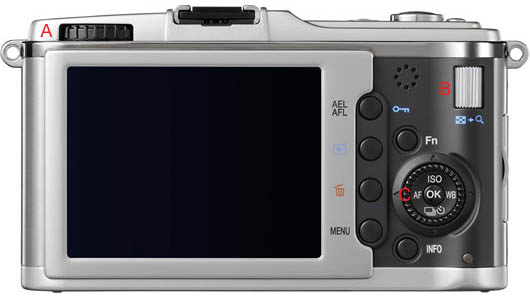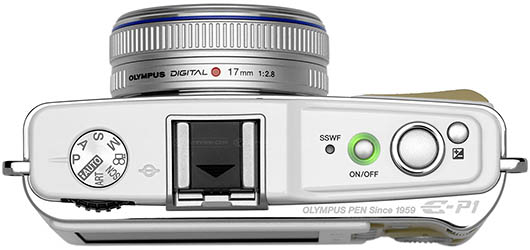Mini-review of the Olympus E-P1
(and – by extension – of the near-identical E-P2)
Page 1. Version 5.0, ©2009, 2010 by Dale Cotton, all rights reserved.
Everything in this review of the E-P1 applies equally to the E-P2, except that the E-P2 is a) black in colour, b) has an attachable finder, c) has a menu option for finder brightness, and d) has two new art filters.

Fig. 1: Olympus promo shots: E-P1 with kit 17mm pancake and kit 14-42 compact zoom
I've own and extensively used the Olympus E-P1 since it was released ten months ago. That's the right amount of time to get over first-blush enthusiasm and second-blush irritations, but – normally – much too long a time to let pass before publishing a review. Howver, not only has the pace of change in digital photography slowed a bit of late, but also the E-P1 is still on store shelves, usually at a bargain price, while the E-P2 is still early in its life cycle.
For an exhaustive technical analysis see the reviews on dpreview.com and Imaging-Resource, but I always find it useful to get as many perspectives as possible when shopping for a new camera, hence this document.
Functionality

Fig. 2: Olympus promo shot: Silver E-P1 back view
(A = mode dial, B = thumb roller, C = thumb ring)
Build quality. The E-P1 has a metal exterior and a pleasant heft that suggests a return to the all-metal construction of days gone by. In fact, the metal exterior is a veneer on carbon composite internal skeleton, but you don't need to tell that to any of the admiring on-lookers that seem to crowd around whenever the camera comes out of its bag.
LCD and finder. The LCD back panel is one of the better ones available except that the resolution is on the low end by today's standards at 230K. On the up-side the LCD panel allows viewing from very extreme angles, which compensates a bit for the lack of hinge-and-swivel. In extremely bright daylight that puts glare directly on the LCD, you still need a finder for accurate framing and ease of reading on-screen info. The E-P2's attachable EVF is one of the best of that breed, but it's still an EVF.
Flash. Neither the E-P1 nor the E-P2 has a built-in flash but both do have a hot shoe.
Video. I have virtually no knowledge in this area, but the E-P1 has monaural sound, 720p, and the AF stepper motors on the Olympus kit lenses are loud enough to be captured.
Lenses. Olympus and Panasonic have a small but growing selection of Micro 4/3 lenses. Speed, as in max aperture, is not one of their strengths, since speed and size stand in opposition, and m4/3 is all about size. The E-P1 accepts a vast gamut of other lenses via adapter, including standard 4/3, Leica M-mount, Nikon F-mount, and Canon. (Caveat the effective focal length of 35mm lenses is doubled on 4/3rds cameras; your 50mm/1.4 transforms into a 100mm portrait lens just by virtue of being mounted on a 4/3 camera.)
Exposure control. Having a real-time histogram always available is a game changer for anyone old enough to no longer believe in Santa Claus and the infallibility of matrix metering. There are two thumb dials B in the illustration above, and a ring, labeled C)--> (labeled B and C in Fig. 2, above) that can be assigned to shutter and aperture; ISO is accessed by button press then thumb wheel. Exposure compensation and AEL/AFL lock also have their own buttons. Only complaint is that the thumb ring is sensitive and fiddly.
Customization. The E-P1 has a very complete suite of menu options, including dozens of custom functions: directly imported from the Olympus SLR line without the least bit of dumbing-down.
Shutter noise. The E-P1 has the same default-open shutter mechanism as the Panasonic G1 and GH1, so it also has a similar muted but definitely not silent shutter activation click. It's much quieter than a traditional film SLR (comparison), noticeably quieter than a digital SLR (comparison), noticeably quieter than a Leica M (comparison), but not silent.
Performance

Fig. 3: Olympus promo shot: White E-P1 top view
AF. After four successive firmware updates (from 1.0 to 1.4) the E-P1 now sports auto focus performance approaching that of the Panasonic G series and that of the phase detection AF in lower-end dSLRs. This breaks down in very low light levels and varies with the attached lens. AF speed is as much a function of lens construction as it is of the firmware in the camera body. The kit 14-42, while acceptable, is not the best performer, having been designed for compactness first and everything else second. Between EVF and less-than-stellar AF, the E-P1 is not going to show up in track or field camera pits anytime soon, nor in birder's bags. But it can be used quite handily for children at play (one of those areas in which you have to learn how to use it.)
Shutter lag and shot-to-shot. At 0.072 sec the E-P1's pre-focus shutter lag is right on par with the dSLR crowd. Shot-to-shot time is pokey by dSLR standards – something around one second – but, since the LCD is blacked out for the duration it can seem worse than it actually is.
IS. Image stabilization on the E-P1 is not as good as that on dSLRs – it's superior: and rather significantly so in my experience. The camera body already has enough heft to dampen a fair amount of vibration; but the sensor unit is light enough that it responds superbly to IS. I routinely work at slower than 1/10th second speeds and hardly want for a tripod at 1/30th. Just as critically, there's no lag time as there is on my dSLR: IS in continuous mode is always up to speed. And of course the E-P1 implementation of IS is in-body, not in-lens, meaning it works along with any of your old dSLR or 35mm lenses you attach via adaptor.